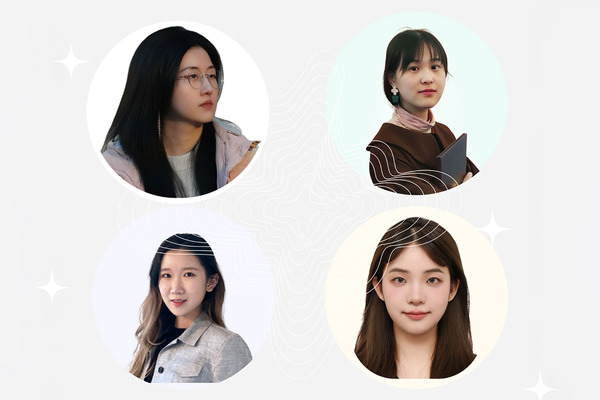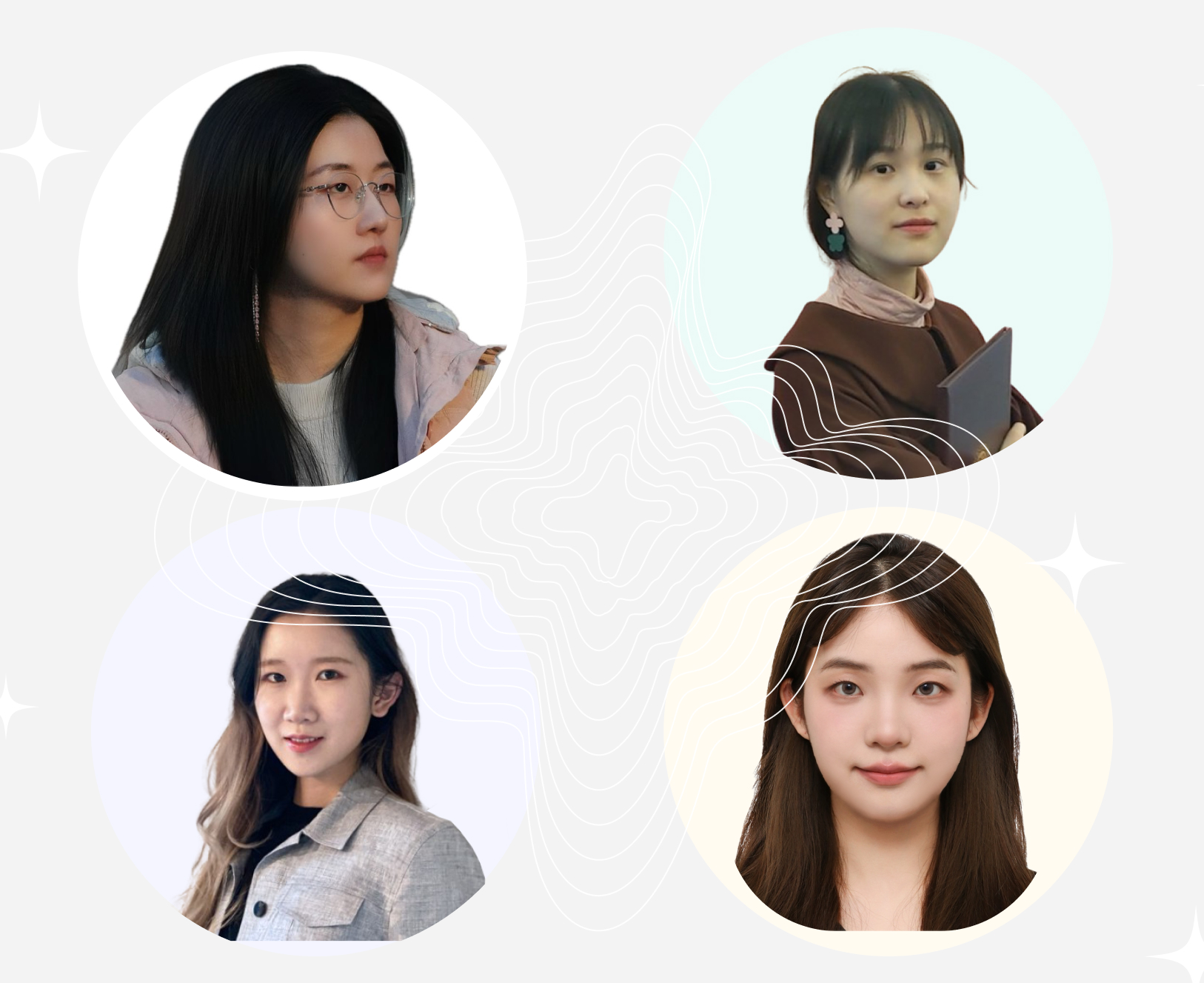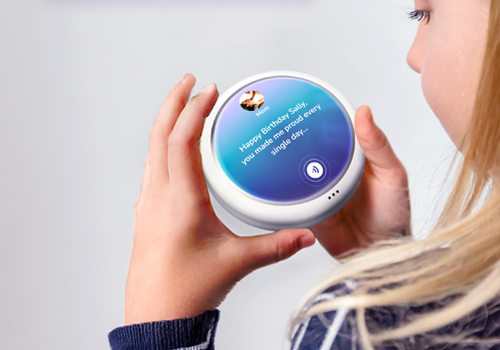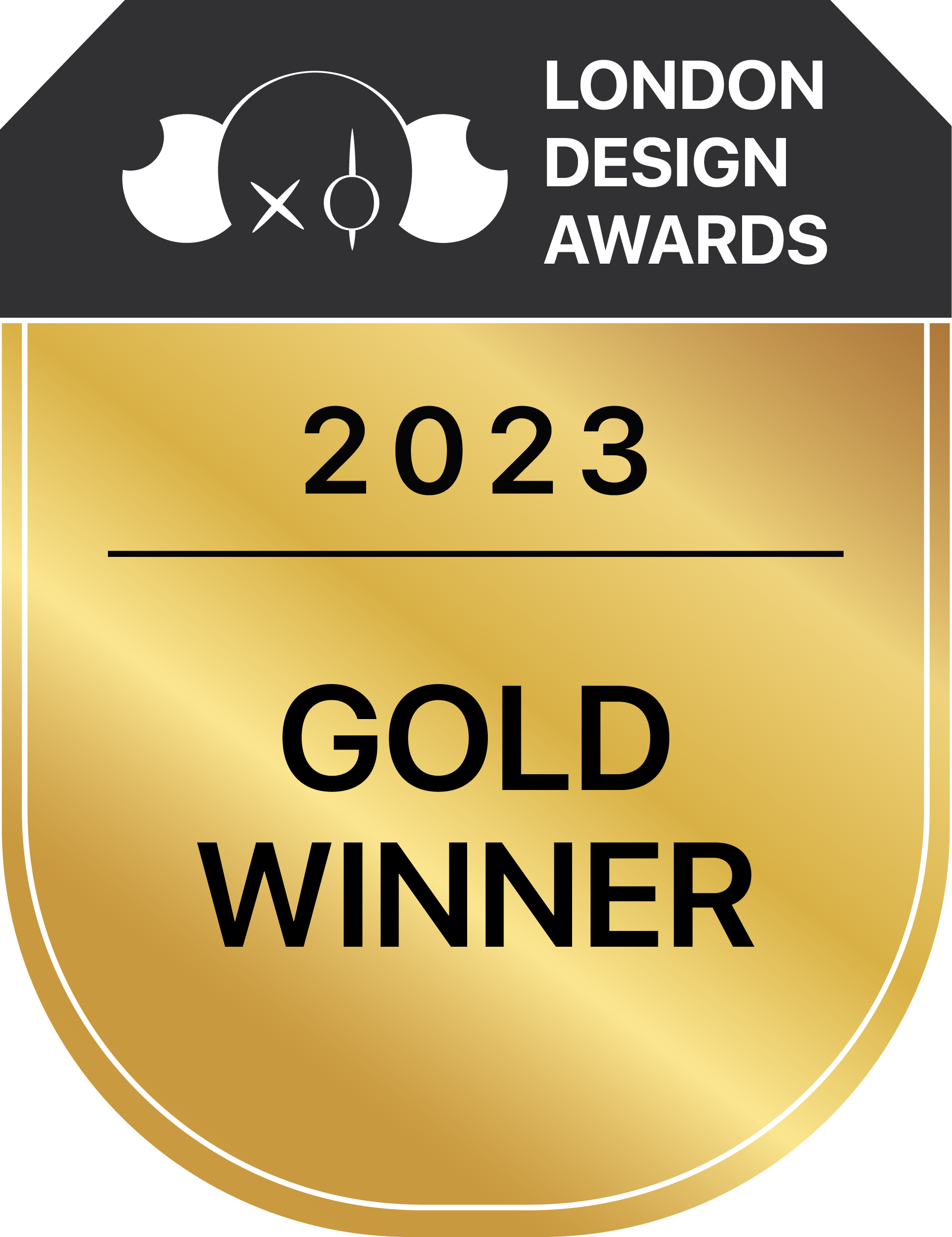
Junru Xu, Zhongqi Fu, Zixi Liu, and Yiwen Chen
1. Please give us a brief bio of yourself and your design background.
Junru: My name is Junru "Jennie" Xu, and I am a UX design lead with a master's degree from Columbia University. I have eight years of experience in UX/UI design and currently serve as a Senior UX Designer at DirecTV, where I spearhead major design initiatives for the upper funnel, driving positive impacts that enhance revenue and bolster customer retention. Beyond my professional endeavors, I am also an artist and an entrepreneur. As the co-founder and CEO of TA Design Studio, I aim to offer top-tier mentorship, empowering aspiring UX designers to refine their soft and technical skills while providing consultancy to craft standout UX portfolios. Partnering with HMW Design Studio, I am dedicated to leveraging creativity for social good, championing design innovation that addresses contemporary societal challenges with an eye towards the future.
Zhongqi: I'm Zhongqi "Elisa" Fu, from Boston, with a master's degree from Columbia University and five years of experience in UX/UI. I am known for devising solutions that significantly enhance everyday life across various sectors. As a pivotal force at Electric Hydrogen Co., I lead the development of IoT enterprise products, aiming for zero emissions in the energy industry. In my co-founding role at TA Design Studio, I have mentored budding designers, fostering their growth and career progression.
Zixi: I am Zixi Liu, and with my background as a therapist, I bring a unique empathy-driven approach to UX/product design. My focus is on creating digital experiences that are intuitive, accessible, and inspiring. At VMware, I contribute to designing enterprise-level solutions that redefine the landscape of software development, while my tenure at Sibel Health was marked by designing comprehensive healthcare solutions to seamlessly connect patients, clinicians, and researchers.
Yiwen: My name is Yiwen Chen, a UI/UX designer from the School of Visual Arts. I delve deeply into mental health and societal issues, aiming to cultivate a more empathetic and inclusive community through my designs. My work embodies a commitment to addressing these critical themes, reflecting a vision for a kinder society.
2. What made you become/why did you choose to become a designer/artist?
As beings drawn to visual beauty, we find great satisfaction in creating stunning designs. Our role as UX designers places us at the center of a user-focused field that uniquely blends design, technology, and psychology. This synergy not only drives impactful designs but also addresses human needs, enhancing problem-solving and improving quality of life.
With dedication and creativity, we use our design talents to transform the world, integrating meaningful design into everyday life. This effort reflects our commitment to excellence and underscores our role in crafting a more intuitive and enjoyable human experience.
3. Tell us more about your agency/company, job profile, and what you do.
TA Studio has a long-term commitment to providing high-quality design services in mentorship, architectural design, graphic/web design, UX/UI design, and product design. We stay abreast of the latest trends and knowledge in the design industry to pass on fresh insights to our students, helping them set career goals for a lifelong future.
HMW Design Studio is dedicated to shaping a future where creativity drives positive social change. Focused on impact-driven design innovation, we craft experiences that are both forward-looking and deeply rooted in addressing today's societal challenges.
4. What does “design” mean to you?
Design is an exploration of possibilities, bridging the imagined and the tangible. It brings ideas to life, turning abstract concepts into physical or digital realities that touch every aspect of our lives. Through design, we communicate without words, conveying messages and emotions through colours, shapes, and spaces, crafting experiences that resonate personally. It requires a deep understanding of human behavior and empathy to anticipate and meet the unspoken needs and desires of users.
Furthermore, design reflects societal values and trends, evolving to address new challenges and leverage technological advancements. It is a continuous dialogue with the world, a responsive and dynamic process adapting to the ever-changing landscape of human interaction. Design not only solves problems but also anticipates future needs, pushing the boundaries of innovation to create solutions that are both practical and inspirational. At its core, design is about connection.
5. What’s your favorite kind of design and why?
A design concept that captivates many with its profound impact and elegance is minimalism. This philosophy, marked by simplicity, clean lines, and a monochromatic colour palette, embodies the 'less is more' approach. Minimalism strips away the unnecessary, focusing on essential elements to achieve functionality and aesthetic clarity.
It resonates with people by creating a sense of calm and order, making spaces and products feel more approachable and user-friendly. This design style demonstrates that beauty and functionality can coexist without complexity, showcasing the power of simplicity in connecting with users on a fundamental level. Minimalist design stands out for its ability to communicate more by showing less, a principle that is both challenging and rewarding to implement.
6. To you, what makes a “good” design?
A blend of simplicity and functionality is what makes a good design, ensuring that every element serves a purpose while maintaining visual charm. The usability, making interactions intuitive, and accessible to a wide audience should be a priority. Beyond immediate utility, good design promotes an emotional connection, telling a story or evoking feelings that resonate deeply with users. Attention to detail, sustainability, and adaptability to evolving needs and feedback are also crucial for ensuring that a design remains relevant and effective over time.
7. How did you come up with the idea for your award-winning design?
We aim to bridge the emotional distance for children growing up without the constant presence of their parents, fostering deeper bonds and enriching family connections. YOYO primarily targets "left-behind" children and their parents, as well as families seeking to strengthen their interactions. These children, aged 0 to 17, often endure their parents' absence due to work obligations, facing significant challenges in social integration, mental well-being, and familial ties.
8. What was your main source of inspiration for this design?
The inspiration for the Yo-Yo design project stemmed from the traditional Yo-Yo toy, a timeless symbol of childhood that transcends cultural boundaries. Known for its enduring appeal among children, this simple yet engaging toy provided the foundation for creating a device that is both entertaining and therapeutic. The Yo-Yo toy's ability to captivate and stimulate playful interactions shaped our vision to design a product that encourages physical activity and peer-to-peer engagement while seamlessly integrating health monitoring and emotional well-being support.
By incorporating the Yo-Yo's playful essence, we aimed to reimagine how children interact with technology, transforming nostalgia into a modern tool for mental health care. This approach addresses the challenges faced by families in today's fast-paced world, where parents and children often experience physical and emotional distances due to work commitments and lifestyle demands. By merging the tangible joy of playing with a Yo-Yo with advanced health monitoring technology, we envisioned a device that fosters stronger emotional connections between parents and their children, bridging communication gaps and offering a sense of security and closeness, regardless of physical distance.
This blend of traditional play and contemporary technology underscores our commitment to addressing critical societal issues through innovative design. It demonstrates a deep understanding of the emotional and psychological needs of children and the importance of maintaining strong family bonds. Through the Yo-Yo project, we aimed to highlight the role of design in improving mental health awareness and care, ensuring that children feel supported and connected to their loved ones, thereby enhancing their emotional resilience and overall well-being.
9. Do you think your country and its cultural heritage has an impact on your design process?
Absolutely! Our shared background from China has deeply shaped our design philosophy, particularly as we've witnessed the prevalent challenges within traditional Chinese families.
10. Congratulations! As the winner of the London Design Awards, what does it mean to you and your company and team to receive this award distinction?
Receiving the Gold Award at the London Design Awards is a tremendous honour and a profound validation of our dedication, creativity, and perseverance. This accolade goes beyond recognising the aesthetic appeal or innovation of our design; it signifies the impact and relevance of our work in addressing critical societal issues through thoughtful design.
This award holds special significance as it underscores the importance of the Yo-Yo project, which focuses on improving children's mental health and strengthening family bonds across distances. It affirms our approach of integrating traditional elements with modern technology to create a product that engages children while supporting parents. This recognition reinforces the growing importance of mental health and emotional well-being in today's world.
11. Can you explain a bit about the winning work you entered into the London Design Awards, and why you chose to enter this project?
We chose to submit the Yo-Yo project to the London Design Awards for several compelling reasons. Firstly, it embodies our commitment to addressing critical societal issues through thoughtful design, specifically focusing on children's mental health—a vital yet often overlooked area. Our goal was to bridge the gap between technology and emotional care in a practical and accessible way.
Moreover, the project showcases our innovative design approach, blending traditional play with cutting-edge technology to create a product that is both functional and emotionally resonant. This integration reflects our holistic design philosophy, centered on user-centric solutions and social responsibility.
Entering the project into the awards aimed to emphasise the role of design thinking in solving real-world challenges and inspire others in the design community to contribute to societal well-being. Winning the award not only recognised our team's dedication and creativity but also provided a platform to raise awareness about the importance of supporting children's mental health. It reaffirmed our belief in the transformative power of design to positively impact individuals and communities, driving us to continue innovating for meaningful change.
12. What were the main challenges you faced during the design process, and how did you overcome them?
During the design journey of the Yo-Yo project, we encountered several challenges in crafting a product that was both innovative and deeply meaningful for children:
Balancing Playfulness with Functionality: Our main challenge was to create a device that appealed to children's sense of play while also functioning effectively as a health monitoring tool. Through extensive user research, we ensured the Yo-Yo was engaging for children yet practical for health monitoring purposes.
Integrating Advanced Technology in a Child-Friendly Design: Incorporating health monitoring sensors and connectivity in a safe and appealing design requires careful material and technology selection. Collaboration with engineers and child psychologists was crucial to achieving a balance between technical sophistication and child-friendliness.
Ensuring Privacy and Security: Handling sensitive health data demanded robust data protection measures. We implemented top-tier encryption and security practices to safeguard users' information, addressing privacy concerns for both children and parents.
Distinguishing Our Design in a Crowded Market: Amidst numerous connected health devices, distinguishing the Yo-Yo was vital. Inspired by children's daily activities, we designed it with three functional states: as a clock during study times, a traditional Yo-Yo for play, and a communication tool for voice messages with parents. Visual cues like colours and facial expressions intuitively display mood and health status, enhancing engagement in health monitoring.
By tackling these challenges with a user-centered, research-driven approach, we created the Yo-Yo as a versatile device that uniquely blends fun, functionality, and emotional support. This innovative approach not only sets the Yo-Yo apart in the market but also underscores our commitment to designing solutions that positively impact users' lives.
13. How do you think winning this award will impact your future as a designer?
Winning the Gold Award at the London Design Awards represents a transformative milestone for us, significantly boosting our visibility and credibility within the design community. It has opened doors to new opportunities and collaborations that were previously beyond our reach. This recognition serves as a powerful validation of our approach to creating innovative and impactful designs, inspiring us to continually push the boundaries of what's achievable in design.
The award has expanded our professional network, connecting us with industry peers and leaders, enriching our journey, and fostering collaborative growth opportunities. Beyond professional advancement, it provides a platform to advocate for causes we deeply care about, particularly using design to tackle societal challenges, thereby amplifying our impact.
Encouraged by this achievement, we are driven to pursue continuous learning and experimentation, refining our skills and deepening our commitment to making a positive contribution to the world through thoughtful and meaningful design.
14. What are your top three (3) favorite things about the design industry?
First and foremost, the boundless opportunity for creative problem-solving is what truly captivates us about design. It's about finding innovative solutions that often defy conventional thinking. This aspect of design immerses us in a creative process where each challenge becomes a puzzle to be solved with imagination, intuition, and ingenuity. Our goal isn't just to create visually appealing products; it's to craft transformative solutions that enhance usability, bring joy, and add convenience to users' lives. The satisfaction of turning abstract ideas into tangible realities that positively impact people's experiences is immensely fulfilling.
Secondly, the focus on user-centered design deeply resonates with our approach. This philosophy prioritises understanding the needs, emotions, and behaviors of users throughout the design process. It ensures that our work isn't just functional but empathetically aligned with the people it serves. By delving into the nuances of human interaction with products and services, we aim to improve the user experience with every design decision. This approach infuses our designs with purpose and relevance, creating intuitive, accessible, and meaningful connections between humans and the designed world. It challenges us to consider multiple perspectives, fostering a design ethos that is both compassionate and creative.
Lastly, the dynamic and ever-evolving landscape of the design industry is exhilarating to us. The constant introduction of new technologies, methodologies, and trends ensures that learning never stops. This ongoing evolution keeps us engaged and pushes us to continuously refine our skills, experiment with new tools, and stay informed about emerging trends. It's a field where change is constant, presenting an exciting challenge to innovate and adapt. This environment not only drives our growth as designers but also ensures that our work remains at the forefront of what's possible. Every day presents a new opportunity to explore, learn, and evolve.
15. What sets your design apart from others in the same category?
Our design is distinctive for its dedicated focus on a specific demographic: "left-behind" children and their parents, supplemented by support for families needing assistance in child interaction. These children, aged 0-17, experience extended periods of parental absence due to work-related travel, which can lead to challenges in integration, mental health issues, and strained family ties.
Additionally, our design philosophy is inherently human-centered, characterised by a playful visual style. This approach aims to create a more engaging and empathetic user experience, addressing the emotional and developmental needs of our target audience effectively.
16. Where do you see the evolution of design industry going over the next 5-10 years?
Our team envisions significant evolution in the design industry over the next 5-10 years, driven by technological advancements and shifting societal values. We anticipate standardisation of sustainable design practices, alongside greater integration of AI and automation tools in the design process. Augmented and virtual reality technologies will revolutionise design visualisation, while personalised and adaptive design approaches will cater to individual user needs.
Cross-disciplinary collaboration will be paramount, with a focus on creating solutions that enhance well-being and embrace global cultural diversity. Embracing innovation and human-centered principles will be essential for designers navigating this dynamic and evolving landscape.
17. What advice do you have for aspiring designers who want to create award-winning designs?
We recommend prioritising mastery of your craft through continual skill refinement and staying abreast of industry trends and technologies. Develop a strong foundation in design principles, user needs, and market dynamics, while nurturing creativity and fostering innovative thinking. Embrace collaboration, actively seek feedback from peers, and be open to experimentation and calculated risks. Above all, maintain passion and dedication, allowing your unique perspective and voice to shine through in your design endeavors.
18. What resources would you recommend to someone who wants to improve their skills in the design industry?
Consider exploring a curated mix of resources tailored to your specific interests and goals. Begin with online learning platforms such as Coursera, Udemy, or Skillshare, which offer a range of courses spanning graphic design, web design, UX/UI, and industrial design. Foundational books like Don Norman's "The Design of Everyday Things" and William Lidwell's "Universal Principles of Design" can deepen your understanding.
Engage actively with design communities on platforms like Behance and Dribbble to showcase your work, receive feedback, and learn from peers. Attend workshops and conferences for networking and insights from industry professionals. Remember, consistent practice is key to mastering your craft.
19. Tell us something you have never told anyone else.
Our team works 100% remotely!
20. Who has inspired you in your life and why?
The array of individuals I've encountered throughout my life has been a wellspring of inspiration for me. Each person, with their distinct experiences, perspectives, and qualities, holds a special place in shaping my outlook. From family members and friends to mentors and even strangers, everyone I've crossed paths with has contributed to my growth and understanding in unique ways.
21. What is your key to success? Any parting words of wisdom?
Cultivate self-confidence by acknowledging your strengths, learning from your experiences, and embracing failure as a stepping stone towards growth. Trusting yourself empowers you to make decisions, take risks, and pursue your goals with determination and resilience.


